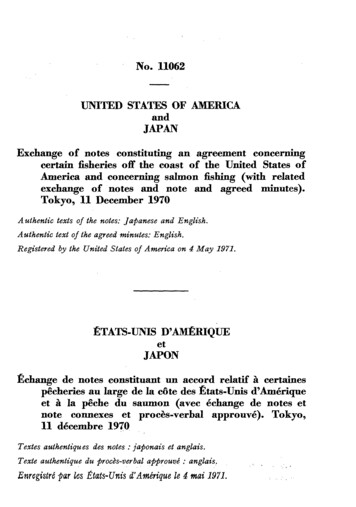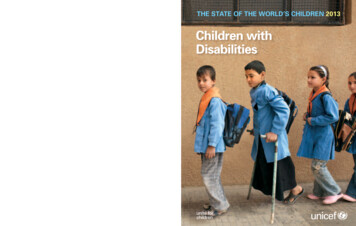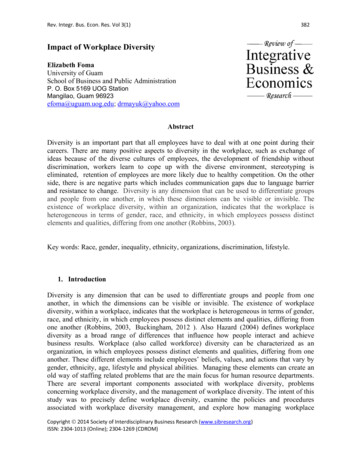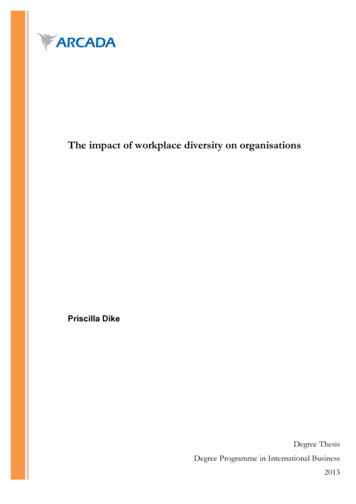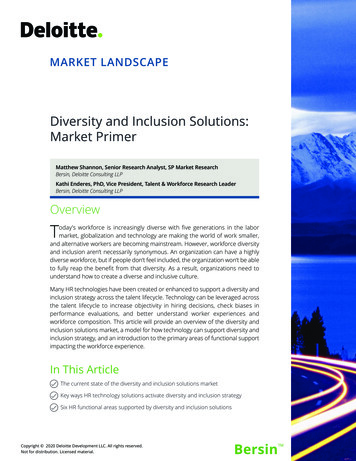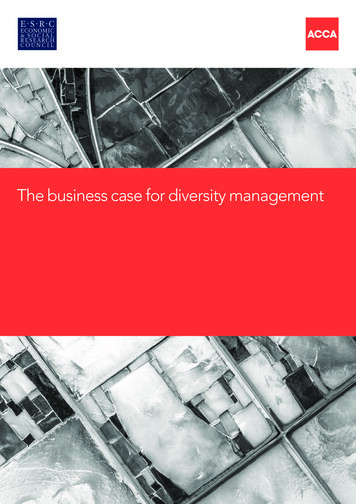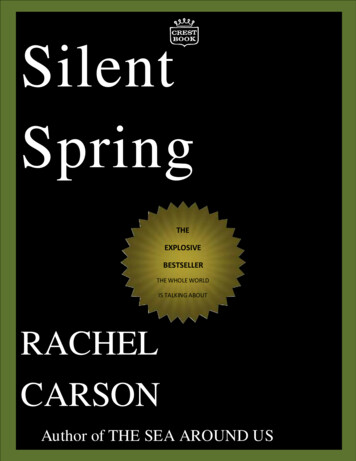
Transcription
SilentSpringTHEEXPLOSIVEBESTSELLERTHE WHOLE WORLDIS TALKING ABOUTRACHELCARSONAuthor of THE SEA AROUND US
SILENT SPRING, winner of 8 awards*, is the history making bestseller thatstunned the world with its terrifying revelation about our contaminated planet. No sciencefiction nightmare can equal the power of this authentic and chilling portrait of the un-seendestroyers which have already begun to change the shape of life as we know it.“Silent Spring is a devastating attack on human carelessness, greed andirresponsibility. It should be read by every American who does not want it to be the epitaph ofa world not very far beyond us in time.”--- Saturday Review*Awards received by Rachel Carson for SILENT SPRING: The Schweitzer Medal (Animal Welfare Institute)The Constance Lindsay Skinner Achievement Award for merit in the realm of books (Women’sNational Book Association)Award for Distinguished Service (New England Outdoor Writers Association)Conservation Award for 1962 (Rod and Gun Editors of Metropolitan Manhattan)Conservationist of the Year (National Wildlife Federation)1963 Achievement Award (Albert Einstein College of Medicine --- Women’s Division)Annual Founders Award (Isaak Walton League)Citation (International and U.S. Councils of Women)
Silent Spring( By Rachel Carson ) “I recommend SILENT SPRING above all other books.” --- N. J. Berrill author of MAN’SEMERGING MIND"Certain to be history-making in its influence upon thought and public policy all over theworld." --Book-of-the-Month Club News"Miss Carson is a scientist and is not given to tossing serious charges around carelessly.When she warns us, as she does with such a profound sense of urgency, we ought totake heed. SILENT SPRING may well be one of the great and lowering books of our time.This book is must reading for every responsible citizen." --Chicago Daily"Miss Carson's cry of warning is timely. If our species cannot police itself againstoverpopulation, nuclear weapons and pollution, it may become extinct." --The New YorkTimes"A great woman has awakened the Nation by her forceful account of the dangersaround us. We owe much to Rachel Carson." --Stewart L. Udall, Secretary of the Interior"It is high time for people to know about these rapid changes in their environment, andto take an effective part in the battle that may shape the future of all life on earth." -TheNew York Times Book Review{front page}"It should come as no surprise that the gifted author of THE SEA AROUN US can takeanother branch of science . and bring it so sharply into focus that any intelligentlayman can understand what she is talking about. Understand, yes, and shudder, for shehas drawn a living portrait of what is happening to this balance of nature as decreed inthe science of life --- and what man is doing (and has done) to destroy it and create ascience of death." -Virginia Kirkus Bulletin
SilentSpringBy Rachel Carson(ONE SIN GLE BOOK WHICH BROUGHT THE ISSUE OF PESTICIDES CENTERSTAGE. WITH MASS SCALE POISONINGOF THE LAND WITH PESTICIDES AN D WITH THOUSAN DS OF FARMERS COMMITTIN G SUICIDE THIS BOOK ISESSENTIAL FOR PUBLIC RESEARCH IN IN DIA.)A CREST REPRINTFAWCETT PUBLICATIONS, INC., GREENWICH, CONN.MEMBER OF AMERICAN BOOK PUBLISHERS COUNCIL, INC.
To Albert Schweitzerwho said“Man has lost the capacity to foreseeand to forestall. He will end bydestroying the earth.”
Contentsi. Acknowledgmentsii. Foreword1. A Fable for Tomorrow2. The Obligation to Endure3. Elixirs of Death4. Surface Waters and Underground Seas5. Realms of the Soil6. Earth’s Green Mantle7. Needless Havoc8. And No Birds Sing9. Rivers of Death10. Indiscriminately from the Skies11. Beyond the Dreams of the Borgias12. The Human Price13. Through a Narrow Window14. One in Every Four15. Nature Fights Back16. The Rumblings of an Avalanche17. The Other Road
AcknowledgmentsIN A LETTER written in January 1958, Olga Owens Huckins told me of her own bitterexperience of a small world made lifeless, and so brought my attention sharply back to aproblem with which I had long been concerned. I then realized I must write this book.During the years since then I have received help and encouragement from so many people thatit is not possible to name them all here. Those who have freely shared with me the fruits ofmany years’ experience and study represent a wide variety of government agencies in this andother countries, many universities and research institutions, and many professions. To all ofthem I express my deepest thanks for time and thought so generously given.In addition my special gratitude goes to those who took time to read portions of the manuscriptand to offer comment and criticism based on their own expert knowledge. Although the finalresponsibility for the accuracy and validity of the text is mine, I could not have completed thebook without the generous help of these specialists: L. G. Bartholomew, M.D., of the MayoClinic, John J. Biesele of the University of Texas, A. W. A. Brown of the University of WesternOntario, Morton S. Biskind, M.D., of Westport, Connecticut, C. J. Briejer of the Plant ProtectionService in Holland, Clarence Cottam of the Rob and Bessie Welder Wildlife Foundation, GeorgeCrile, Jr., M.D., of the Cleveland Clinic, Frank Egler of Norfolk, Connecticut, Malcolm M.Hargraves, M.D., of the Mayo Clinic, W. C. Hueper, M.D., of the National Cancer Institute, C. J.Kerswill of the Fisheries Research Board of Canada, Olaus Murie of the Wilderness Society, A. D.Pickett of the Canada Department of Agriculture, Thomas G. Scott of the Illinois Natural HistorySurvey, Clarence Tarzwell of the Taft Sanitary Engineering Center, and George J. Wallace ofMichigan State University. Every writer of a book based on many diverse facts owes much tothe skill and helpfulness of librarians. I owe such a debt to many, but especially to Ida K.Johnston of the Department of the Interior Library and to Thelma Robinson of the Library of theNational Institutes of Health.As my editor, Paul Brooks has given steadfast encouragement over the years and hascheerfully accommodated his plans to postponements and delays. For this, and for his skillededitorial judgment, I am everlastingly grateful. I have had capable and devoted assistance in theenormous task of library research from Dorothy Algire, Jeanne Davis, and Bette Haney Duff.And I could not possibly have completed the task, under circumstances sometimes difficult,except for the faithful help of my housekeeper, Ida Sprow.Finally, I must acknowledge our vast indebtedness to a host of people, many of themunknown to me personally, who have nevertheless made the writing of this book seemworthwhile. These are the people who first spoke out against the reckless and irresponsiblepoisoning of the world that man shares with all other creatures, and who are even now fightingthe thousands of small battles that in the end will bring victory for sanity and common sense inour accommodation to the world that surrounds us.RACHEL CARSON
ForewordIN 1958, when Rachel Carson undertook to write the book that became Silent Spring,she was fifty years old. She had spent most of her professional life as a marine biologist andwriter with the U.S. Fish and Wildlife Service. But now she was a world-famous author, thanksto the fabulous success of The Sea Around Us, published seven years before. Royalties from thisbook and its successor, The Edge of the Sea, had enabled her to devote full time to her ownwriting. To most authors this would seem like an ideal situation: an established reputation,freedom to choose one’s own subject, publishers more than ready to contract for anything onewrote. It might have been assumed that her next book would be in a field that offered the sameopportunities, the same joy in research, as did its predecessors. Indeed she had such projects inmind. But it was not to be. While working for the government, she and her scientific colleagueshad become alarmed by the widespread use of DDT and other long-lasting poisons in so-calledagricultural control programs. Immediately after the war, when these dangers had already beenrecognized, she had tried in vain to interest some magazine in an article on the subject. Adecade later, when the spraying of pesticides and herbicides (some of them many times as toxicas DDT) was causing wholesale destruction of wildlife and its habitat, and clearly endangeringhuman life, she decided she had to speak out. Again she tried to interest the magazines in anarticle. Though by now she was a well-known writer, the magazine publishers, fearing to loseadvertising, turned her down. For example, a manufacturer of canned baby food claimed thatsuch an article would cause “unwarranted fear” to mothers who used his product. (The oneexception was The New Yorker, which would later serialize parts of Silent Spring in advance ofbook publication.) So the only answer was to write a book—book publishers being free ofadvertising pressure. Miss Carson tried to find someone else to write it, but at last she decidedthat if it were to be done, she would have to do it herself. Many of her strongest admirersquestioned whether she could write a salable book on such a dreary subject. She shared theirdoubts, but she went ahead because she had to. “There would be no peace for me,” she wroteto a friend, “if I kept silent.”Silent Spring was over four years in the making. It required a very different kind ofresearch from her previous books. She could no longer recount the delights of the laboratoriesat Woods Hole or of the marine rock pools at low tide. Joy in the subject itself had to bereplaced by a sense of almost religious dedication. And extraordinary courage: during the finalyears she was plagued with what she termed “a whole catalogue of illnesses.”Also she knew very well that she would be attacked by the chemical industry. It was not simplythat she was opposing indiscriminate use of poisons but—more fundamentally—that she hadmade clear the basic irresponsibility of an industrialized, technological society toward thenatural world. When the attack did come, it was probably as bitter and unscrupulous asanything of the sort since the publication of Charles Darwin’s Origin of Species a century before.Hundreds of thousands of dollars were spent by the chemical industry in an attempt todiscredit the book and to malign the author—she was described as an ignorant and hystericalwoman who wanted to turn the earth over to the insects. These attacks fortunately backfiredby creating more publicity than the publisher possibly could have afforded. A major chemical
company tried to stop publication on the grounds that Miss Carson had made a misstatementabout one of their products. She hadn’t, and publication proceeded on schedule.She herself was singularly unmoved by all this furor.Meanwhile, as a direct result of the message in Silent Spring, President Kennedy set up aspecial panel of his Science Advisory Committee to study the problem of pesticides. The panel’sreport, when it appeared some months later, was a complete vindication of her thesis. RachelCarson was very modest about her accomplishment. As she wrote to a close friend when themanuscript was nearing completion: “The beauty of the living world I was trying to save hasalways been uppermost in my mind—that, and anger at the senseless, brutish things that werebeing done. Now l can believe I have at least helped a little.” In fact, her book helped to makeecology, which was an unfamiliar word in those days, one of the great popular causes of ourtime. It led to environmental legislation at every level of government.Twenty-five years after its original publication, Silent Spring has more than a historicalinterest. Such a book bridges the gulf between what C. P. Snow called “the two cultures.”Rachel Carson was a realistic, well-trained scientist who possessed the insight and sensitivity ofa poet. She had an emotional response to nature for which she did not apologize. The more shelearned, the greater grew what she termed “the sense of wonder.” So she succeeded in makinga book about death a celebration of life. Rereading her book today, one is aware that itsimplications are far broader than the immediate crisis with which it dealt. By awaking us to aspecific danger—the poisoning of the earth with chemicals—she has helped us to recognizemany other ways (some little known in her time) in which mankind is degrading the quality oflife on our planet.And Silent Spring will continue to remind us that in our over-organized and overmechanized age, individual initiative and courage still count: change can be brought about, notthrough incitement to war or violent revolution, but rather by altering the direction of ourthinking about the world we live in.
1. A Fable for TomorrowTHERE WAS ONCE a town in the heart of America where all life seemed to live inharmony with its surroundings. The town lay in the midst of a checkerboard of prosperousfarms, with fields of grain and hillsides of orchards where, in spring, white clouds of bloomdrifted above the green fields. In autumn, oak and maple and birch set up a blaze of color thatflamed and flickered across a backdrop of pines. Then foxes barked in the hills and deer silentlycrossed the fields, half hidden in the mists of the fall mornings.Along the roads, laurel, viburnum and alder, great ferns and wildflowers delighted the traveler’seye through much of the year. Even in winter the roadsides were places of beauty, wherecountless birds came to feed on the berries and on the seed heads of the dried weeds risingabove the snow. The countryside was, in fact, famous for the abundance and variety of its birdlife, and when the flood of migrants was pouring through in spring and fall people traveled fromgreat distances to observe them. Others came to fish the streams, which flowed clear and coldout of the hills and contained shady pools where trout lay. So it had been from the days manyyears ago when the first settlers raised their houses, sank their wells, and built their barns.Then a strange blight crept over the area and everything began to change. Some evil spell hadsettled on the community: mysterious maladies swept the flocks of chickens; the cattle andsheep sickened and died. Everywhere was a shadow of death. The farmers spoke of muchillness among their families. In the town the doctors had become more and more puzzled bynew kinds of sickness appearing among their patients. There had been several sudden andunexplained deaths, not only among adults but even among children, who would be strickensuddenly while at play and die within a few hours.There was a strange stillness. The birds, for example—where had they gone? Many peoplespoke of them, puzzled and disturbed. The feeding stations in the backyards were deserted. Thefew birds seen anywhere were moribund; they trembled violently and could not fly. It was aspring without voices. On the mornings that had once throbbed with the dawn chorus of robins,catbirds, doves, jays, wrens, and scores of other bird voices there was now no sound; onlysilence lay over the fields and woods and marsh.On the farms the hens brooded, but no chicks hatched. The farmers complained that they wereunable to raise any pigs—the litters were small and the young survived only a few days. Theapple trees were coming into bloom but no bees droned among the blossoms, so there was nopollination and there would be no fruit. The roadsides, once so attractive, were now lined withbrowned and withered vegetation as though swept by fire. These, too, were silent, deserted byall living things. Even the streams were now lifeless. Anglers no longer visited them, for all thefish had died.In the gutters under the eaves and between the shingles of the roofs, a white granular powderstill showed a few patches; some weeks before it had fallen like snow upon the roofs and thelawns, the fields and streams. No witchcraft, no enemy action had silenced the rebirth of newlife in this stricken world. The people had done it themselves. . .This town does not actually exist, but it might easily have a thousand counterparts inAmerica or elsewhere in the world. I know of no community that has experienced all the
misfortunes I describe. Yet every one of these disasters has actually happened somewhere, andmany real communities have already suffered a substantial number of them. A grim specterhas crept upon us almost unnoticed, and this imagined tragedy may easily become a starkreality we all shall know. What has already silenced the voices of spring in countless towns inAmerica? This book is an attempt to explain.
2. The Obligation to EndureTHE HISTORY OF LIFE on earth has been a history of interaction between living thingsand their surroundings. To a large extent, the physical form and the habits of the earth’svegetation and its animal life have been molded by the environment. Considering the wholespan of earthly time, the opposite effect, in which life actually modifies its surroundings, hasbeen relatively slight. Only within the moment of time represented by the present century hasone species—man—acquired significant power to alter the nature of his world.During the past quarter century this power has not only increased to one of disturbingmagnitude but it has changed in character. The most alarming of all man’s assaults upon theenvironment is the contamination of air, earth, rivers, and sea with dangerous and even lethalmaterials. This pollution is for the most part irrecoverable; the chain of evil it initiates notonly in the world that must support life but in living tissues is for the most part irreversible. Inthis now universal contamination of the environment, chemicals are the sinister and littlerecognized partners of radiation in changing the very nature of the world—the very nature ofits life. Strontium 90, released through nuclear explosions into the air, comes to earth in rain ordrifts down as fallout, lodges in soil, enters into the grass or corn or wheat grown there, and intime takes up its abode in the bones of a human being, there to remain until his death.Similarly, chemicals sprayed on croplands or forests or gardens lie long in soil, entering intoliving organisms, passing from one to another in a chain of poisoning and death. Or they passmysteriously by underground streams until they emerge and, through the alchemy of air andsunlight, combine into new forms that kill vegetation, sicken cattle, and work unknown harm onthose who drink from once pure wells. As Albert Schweitzer has said, ‘Man can hardly evenrecognize the devils of his own creation.’ It took hundreds of millions of years to produce thelife that now inhabits the earth—eons of time in which that developing and evolving anddiversifying life reached a state of adjustment and balance with its surroundings. Theenvironment, rigorously shaping and directing the life it supported, contained elements thatwere hostile as well as supporting. Certain rocks gave out dangerous radiation; even within thelight of the sun, from which all life draws its energy, there were short-wave radiations withpower to injure. Given time—time not in years but in millennia—life adjusts, and a balance hasbeen reached. For time is the essential ingredient; but in the modern world there is no time.The rapidity of change and the speed with which new situations are created follow theimpetuous and heedless pace of man rather than the deliberate pace of nature. Radiation is nolonger merely the background radiation of rocks, the bombardment of cosmic rays, theultraviolet of the sun that have existed before there was any life on earth; radiation is now theunnatural creation of man’s tampering with the atom. The chemicals to which life is asked tomake its adjustment are no longer merely the calcium and silica and copper and all the rest ofthe minerals washed out of the rocks and carried in rivers to the sea; they are the syntheticcreations of man’s inventive mind, brewed in his laboratories, and having no counterparts innature.To adjust to these chemicals would require time on the scale that is nature’s; it would requirenot merely the years of a man’s life but the life of generations. And even this, were it by somemiracle possible, would be futile, for the new chemicals come from our laboratories in an
endless stream; almost five hundred annually find their way into actual use in the United Statesalone. The figure is staggering and its implications are not easily grasped—500 new chemicalsto which the bodies of men and animals are required somehow to adapt each year, chemicalstotally outside the limits of biologic experience.Among them are many that are used in man’s war against nature. Since the mid-1940s over 200basic chemicals have been created for use in killing insects, weeds, rodents, and otherorganisms described in the modern vernacular as ‘pests’; and they are sold under severalthousand different brand names. These sprays, dusts, and aerosols are now applied almostuniversally to farms, gardens, forests, and homes— nonselective chemicals that have the powerto kill every insect, the ‘good’ and the ‘bad’, to still the song of birds and the leaping of fish inthe streams, to coat the leaves with a deadly film, and to linger on in soil—all this though theintended target may be only a few weeds or insects. Can anyone believe it is possible to laydown such a barrage of poisons on the surface of the earth without making it unfit for all life?They should not be called ‘insecticides’, but ‘biocides’. The whole process of spraying seemscaught up in an endless spiral. Since DDT was released for civilian use, a process of escalationhas been going on in which ever more toxic materials must be found. This has happenedbecause insects, in a triumphant vindication of Darwin’s principle of the survival of the fittest,have evolved super races immune to the particular insecticide used, hence a deadlier one hasalways to be developed—and then a deadlier one than that. It has happened also because, forreasons to be described later, destructive insects often undergo a ‘flareback’, or resurgence,after spraying, in numbers greater than before. Thus the chemical war is never won, and all lifeis caught in its violent crossfire.Along with the possibility of the extinction of mankind by nuclear war, the central problem ofour age has therefore become the contamination of man’s total environment with suchsubstances of incredible potential for harm—substances that accumulate in the tissues ofplants and animals and even penetrate the germ cells to shatter or alter the very materialof heredity upon which the shape of the future depends.Some would-be architects of our future look toward a time when it will be possible to alter thehuman germ plasm by design. But we may easily be doing so now by inadvertence, for manychemicals, like radiation, bring about gene mutations. It is ironic to think that man mightdetermine his own future by something so seemingly trivial as the choice of an insect spray.All this has been risked—for what? Future historians may well be amazed by our distortedsense of proportion. How could intelligent beings seek to control a few unwanted species by amethod that contaminated the entire environment and brought the threat of disease and deatheven to their own kind? Yet this is precisely what we have done. We have done it, moreover,for reasons that collapse the moment we examine them. We are told that the enormous andexpanding use of pesticides is necessary to maintain farm production. Yet is our real problemnot one of overproduction? Our farms, despite measures to remove acreages from productionand to pay farmers not to produce, have yielded such a staggering excess of crops that theAmerican taxpayer in 1962 is paying out more than one billion dollars a year as the totalcarrying cost of the surplus-food storage program. And is the situation helped when one branchof the Agriculture Department tries to reduce production while another states, as it did in 1958,‘It is believed generally that reduction of crop acreages under provisions of the Soil Bank willstimulate interest in use of chemicals to obtain maximum production on the land retained in
crops.’ All this is not to say there is no insect problem and no need of control. I am saying,rather, that control must be geared to realities, not to mythical situations, and that themethods employed must be such that they do not destroy us along with the insects. . . The problem whose attempted solution has brought such a train of disaster in its wake is anaccompaniment of our modern way of life. Long before the age of man, insects inhabited theearth—a group of extraordinarily varied and adaptable beings. Over the course of time sinceman’s advent, a small percentage of the more than half a million species of insects have comeinto conflict with human welfare in two principal ways: as competitors for the food supply andas carriers of human disease. Disease-carrying insects become important where human beingsare crowded together, especially under conditions where sanitation is poor, as in time ofnatural disaster or war or in situations of extreme poverty and deprivation. Then control ofsome sort becomes necessary. It is a sobering fact, however, as we shall presently see, that themethod of massive chemical control has had only limited success, and also threatens to worsenthe very conditions it is intended to curb.Under primitive agricultural conditions the farmer had few insect problems. These arose withthe intensification of agriculture—the devotion of immense acreages to a single crop. Such asystem set the stage for explosive increases in specific insect populations. Single-crop farmingdoes not take advantage of the principles by which nature works; it is agriculture as an engineermight conceive it to be. Nature has introduced great variety into the landscape, but man hasdisplayed a passion for simplifying it. Thus he undoes the built-in checks and balances by whichnature holds the species within bounds. One important natural check is a limit on the amountof suitable habitat for each species. Obviously then, an insect that lives on wheat can build upits population to much higher levels on a farm devoted to wheat than on one in which wheat isintermingled with other crops to which the insect is not adapted. The same thing happens inother situations. A generation or more ago, the towns of large areas of the United States linedtheir streets with the noble elm tree. Now the beauty they hopefully created is threatened withcomplete destruction as disease sweeps through the elms, carried by a beetle that would haveonly limited chance to build up large populations and to spread from tree to tree if the elmswere only occasional trees in a richly diversified planting.Another factor in the modern insect problem is one that must be viewed against a backgroundof geologic and human history: the spreading of thousands of different kinds of organisms fromtheir native homes to invade new territories. This worldwide migration has been studied andgraphically described by the British ecologist Charles Elton in his recent book The Ecology ofInvasions. During the Cretaceous Period, some hundred million years ago, flooding seas cutmany land bridges between continents and living things found themselves confined in whatElton calls ‘colossal separate nature reserves’. There, isolated from others of their kind, theydeveloped many new species. When some of the land masses were joined again, about 15million years ago, these species began to move out into new territories—a movement that isnot only still in progress but is now receiving considerable assistance from man.The importation of plants is the primary agent in the modern spread of species, for animalshave almost invariably gone along with the plants, quarantine being a comparatively recent andnot completely effective innovation. The United States Office of Plant Introduction alone hasintroduced almost 200,000 species and varieties of plants from all over the world. Nearly half ofthe 180 or so major insect enemies of plants in the United States are accidental imports from
abroad, and most of them have come as hitchhikers on plants. In new territory, out of reach ofthe restraining hand of the natural enemies that kept down its numbers in its native land, aninvading plant or animal is able to become enormously abundant. Thus it is no accident that ourmost troublesome insects are introduced species. These invasions, both the naturally occurringand those dependent on human assistance, are likely to continue indefinitely. Quarantine andmassive chemical campaigns are only extremely expensive ways of buying time. We are faced,according to Dr. Elton, ‘with a life-and-death need not just to find new technological means ofsuppressing this plant or that animal’; instead we need the basic knowledge of animalpopulations and their relations to their surroundings that will ‘promote an even balance anddamp down the explosive power of outbreaks and new invasions.’Much of the necessary knowledge is now available but we do not use it. We train ecologists inour universities and even employ them in our governmental agencies but we seldom take theiradvice. We allow the chemical death rain to fall as though there were no alternative, whereasin fact there are many, and our ingenuity could soon discover many more if given opportunity.Have we fallen into a mesmerized state that makes us accept as inevitable that which is inferioror detrimental, as though having lost the will or the vision to demand that which is good? Suchthinking, in the words of the ecologist Paul Shepard, ‘idealizes life with only its head out ofwater, inches above the limits of toleration of the corruption of its own environment.Whyshould we tolerate a diet of weak poisons, a home in insipid surroundings, a circle of
“I recommend SILENT SPRING above all other books.” N. J. Berrill author of MAN’S --- EMERGING MIND "Certain to be history-making in its influence upon thought and public policy all over the world." --Book-of-the-Month Club News "Miss Carson is a scientist and i



